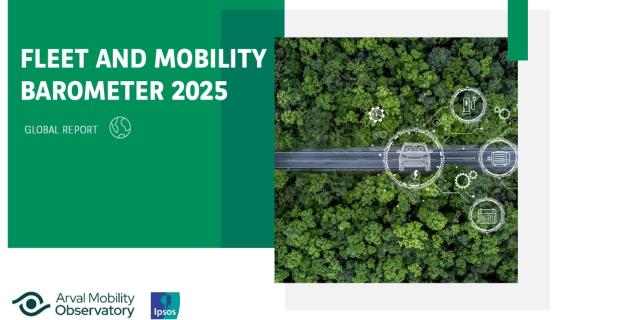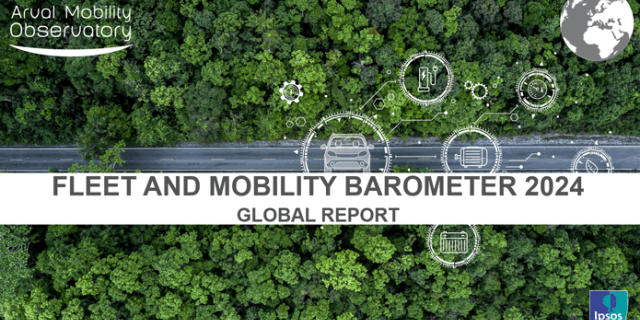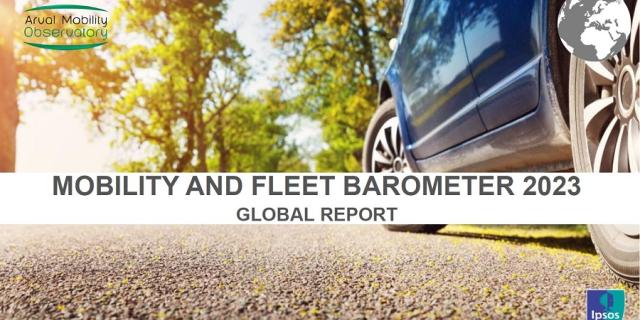The Fleet and Mobility Barometer 2024 reveals: corporates have confidence in the future of fleet, electrification momentum continues, increased interest in mobility solutions implementation and forecasted growth in usage of connected vehicles data
The Arval Mobility Observatory, an industry expert in the recording and forecasting of corporate mobility trends, is releasing the results of its latest barometer, an international survey, unique in terms of scope but also in terms of topics discussed. In 2024, more than 8 600 corporates decision makers were interviewed to gather feedback from 30 countries.
This year, the annual Fleet & Mobility Barometer is bringing forward six key insights. The results of the Barometer present a unique global snapshot on how these trends compare in the 30 countries surveyed.
1. Globally, most companies remain confident about the future of their fleets
91% of the companies expect their fleets to remain stable or grow in the next three years: despite ongoing uncertainties in geopolitics, economics, and the automotive industry, most companies worldwide remain optimistic about the future of their vehicle fleets. The main driver for fleet expansion continues to be the development of their business (73%), followed by HR-related needs (44%). This reinforces the HR consideration for fleet increase for the third year in a row. A clear sign that talent retention and company attractiveness have a significant weight in fleet and mobility decisions.
Amidst the resilience and optimism, the fleet managers have several challenges to tackle in the next three years. While primarily focused on fleet electrification (35% of respondents mentioning this in the top 3 challenges), we see a significant rise on total cost of ownership related concerns (30% in top 3 challenges, an increase of 4 points versus 2023). This can explain the openness of companies to further increase the use of connected vehicles or consider used / second-hand vehicles in their fleet (with 43% of companies declaring they have used/second-hand vehicles in their fleet). Another noticeable increase is the concern towards responsible driving among employees (29% in top 3 challenges, versus 21% in 2023) – linked to both more and more focus on human and sustainability policies we see in other areas of the barometer, as well to the potential cost impact this can have for a fleet.
2. Full-service leasing to continue to grow across all company sizes
Full-service leasing is poised to continue its growth trajectory across companies of all sizes, with 36% companies globally considering its introduction or increasing the usage in their financing models over the next three years. This trend is particularly notable among mid-sized companies, reflecting a broader shift towards leasing solutions in fleet management practices. According to the respondents, today full-service leasing is used as the main financing method by more than 1 out of 4 companies (26%). In Europe, the figure is even higher, at 29%.
3. Driven by CSR related reasons, the fleet electrification momentum continues
70 % of companies have already implemented or are considering implementing at least one of the alternative fuel technologies* on their passenger cars fleet, within the next 3 years.
The main reasons for electrification remain primarily driven by environmental and sustainable policy reasons such as lower environmental impact (38%), companies’ CSR policy (27%), compliance with Low Emission Zones (24%) or anticipation of future restrictive policies (21%) – the last two being on the rise this year.
Looking at the vehicle mix for the future, the fleet managers estimate that 35% of their passenger car fleet will be electrified (PHEV, HEV, BEV) in 3 years from now.
4. The BEVs are expected to continue to grow, with remaining challenges on charging, cost and range of models
36% of companies have already implemented or are considering implementing BEVs on their passenger cars fleet within the next 3 years. If we look at Europe – where the shift has started earlier compared to other regions, the results is at 42%, placing BEVs at a similar level with the other technologies (43% PHEVs, 42% HEV).
An interesting fact is that both current adoption and future consideration for BEVs show increases since 2022 both globally and in Europe, while on the other side, PHEVs and HEVs saw a big increase between 2022-2023, but remain at the same level or even decreased between 2023-2024 – confirming that the growth pace for BEVs is a constant one.
For the companies not considering implementing BEVs to date, the lack of charging infrastructure, higher purchase prices and limited range of models are on top of barriers. The lack of charging points is mentioned by 70% of the respondents, being that is public charging points (35%), at the company premises (31%) or at employees' home (29%).
5. Corporate mobility solutions are increasingly adopted as complement to company cars, sustained by increased HR-related needs
Corporate mobility solutions are gaining traction as a complement to company cars, driven by increased HR-related needs. 75% percent of companies globally have implemented at least one mobility solution**, with mid-size companies leading the trend this year and catching up with the large corporates. Among the mobility solutions that have been implemented or are considered for implementation in the next 3 years, some of the most popular are: Bike leasing (29%), Short or Mid-Term rental vehicles (27%) and Corporate car sharing (23%).
The primary reason for implementing these solutions is increasingly linked to HR-related needs (41%) such as talent recruitment and retention, indicating a shift towards more employee-centric mobility policies. Interestingly, while the mobility solutions are seeing a rise, only 16% of the companies have changed or consider changing their mobility/fleet policy in regards to the development of homeworking. Overall, these solutions remain seen as an add-on to the company fleet, the likelihood to give up all or part of the fleet for mobility solutions remaining pretty low.
6. Connected cars paradox: a high level of cars connected globally, but limited use of telematics data
There is a significant level of connected cars globally, with one in four companies adopting telematics tools, though with significant geographical differences.
A new question added this year shows that 61% of the companies that have connected vehicles are already using or consider using the data coming from the vehicle box thanks to a telematics platform in the next 3 years, a result that is remarkably consistent for both size type and across countries. This figure indicates that the fleet managers understand the potential benefits coming from telematics data as a direct response to their challenges (like fleet electrification, driver safety and cost control), but the operational implementation remains a topic to be tackled in the coming years. Today, we can see a big gap between equipment and data usage: as only 16% of companies equipped claim to be using the data coming through a telematics platform.
“The Fleet and Mobility Barometer offers a unique perspective on 30 countries and 5 continents. This year’s results indicate the appetite of companies of all sizes to grow their fleets with a continued momentum on electrification and a growing interest on mobility solutions.” (Bart Beckers, Arval Deputy CEO and Chief Commercial Officer)
“The Fleet and Mobility Barometer provides a comprehensive view of the evolving fleet landscape. It serves as a benchmark for organizations to make strategic, informed decisions about their business and navigate through the challenges and opportunities that are shaping the future of fleet management and global mobility” (David Madrigal, Executive Vice President and Chief Commercial Officer at Element Fleet Management.)
“ The 2024 results of the Fleet and Mobility Barometer are showing the resilience of fleets in a turbulent environment, across all the 30 countries surveyed and for all sizes of companies. In the same time, we see the growing importance of HR and CSR considerations in broadening the offer of fleet and mobility solutions to a larger part of the staff, making it clear that talent retention and more sustainable mobility solutions are becoming a key aspect for corporates. In this context, the electrification, usage of data from connected cars or adapting mobility policies are the trends that will shape the foreseeable future” (Oana Duma, Head of Arval Mobility Observatory)
The trends observed in the Barometer allow all fleet and mobility stakeholders to better grasp the dynamic and evolution of their ecosystem, leading them to enlightened decisions. To deep dive into the insights presented in this article, please download the full report available at the end of this article.
* The Alternative Fuel Technologies considered in the Barometer are (1) For Passenger Cars - hybrid vehicles (HEVs), plug-in hybrids (PHEVs) and battery electric vehicles (BEVs) and (2) For LCVs - battery electric vehicles (BEVs) and Hydrogen Fuel Cell
** The list of mobility solutions used in the Barometer is: Corporate Car Sharing, Ride Sharing, Bike (or other two wheels) sharing / Bike (or other two wheels) leasing), Public transport, Mobility Budget, An app provided by the company to book mobility solutions, Private Lease or Salary Sacrifice, A short or Mid Term rental vehicle, Car or Cash Allowance
Methodology 2023/2024
For this independent survey, 8 605 companies decisions maker interviews were carried out between August 21st 2023 and November 13th 2023 for 30 countries by an independent research company, Ipsos. Participants were recruited by telephone with a full interview conducted by phone. Its scope covers 30 countries: Austria, Germany, Belgium, Spain, France, Greece, Italy, Luxemburg, the Netherlands, Poland, Portugal, UK, Czech Republic, Slovakia, Romania, Switzerland, Finland, Denmark, Norway, Sweden, New Zealand, Australia, Mexico, Canada, North America, Turkey, Morocco, Chile, Peru and Brazil. The companies in scope operated at least one vehicle.
The distribution of the interviewees was as follows:
- 33 % were companies with less than 10 employees
- 20 % were companies with 10 to 99 employees
- 27 % were companies with 100 to 249/499/999* employees (*dependent on market)
- 20 % were companies with 250/500/1000* employees or more (*dependent on market)
ABOUT THE ARVAL MOBILITY OBSERVATORY
The Arval Mobility Observatory is widely recognised as one of the authoritative research and industry information exchange platforms in the fleet and mobility sector. It aims at collecting and providing objective and accurate information to share with all kinds of audiences, helping them to better understand the new mobility paradigm we are operating in, and supporting them in navigating the jungle that is the ever expanding selection of mobility solutions available.
ABOUT THE ELEMENT-ARVAL GLOBAL ALLIANCE
Managing more than 4.5 million vehicles in 56 countries and delivering products and services with customization to meet local demand, the Element-Arval Global Alliance is the longest standing strategic alliance in fleet management industry and the worldwide leader in fleet management. Clients with global needs benefit from the Alliance’s extended global scale, expert advice, digital tools, global reporting, service delivery and an account team with a single point of contact to support their fleet strategies on all continents. Founded in 1995 the Alliance consists of founding partners Element Fleet Management in the United States, Canada, Mexico, Australia and New Zealand and Arval in 29 countries across four continents. Other partners include Avis Fleet in Southern Africa, Johnson & Perrott in Ireland, Mareauto in Ecuador, RDA Mobility in Argentina and Uruguay, SIXT Mega Rent in Serbia, Montenegro, and Bosnia-Herzegovina, SIXT Transporent in Estonia, Latvia, and Lithuania, and Sumitomo Mitsui Auto Service in Japan, Thailand, and India.












